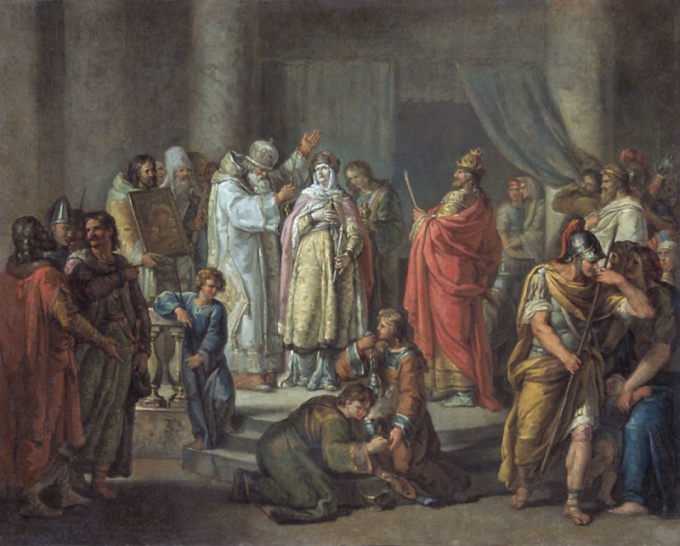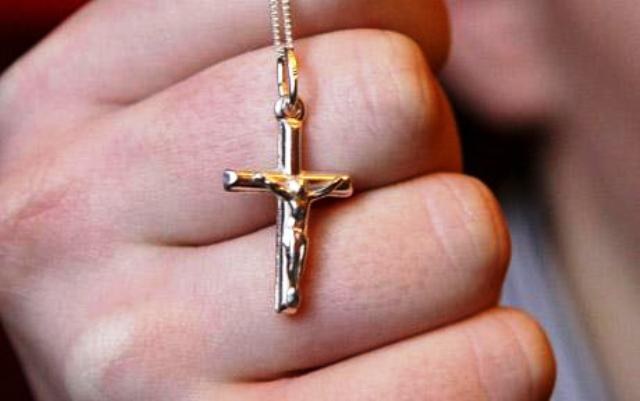Tip 1: Who from Rurikovich first adopted Christianity
Tip 1: Who from Rurikovich first adopted Christianity
The adoption of Christianity by the head of state was an important event for the political development of Rus. This strengthened ties with Byzantium - a potential partner of the nascent Russian state.

The Baptism of Princess Olga
Princess Olga became one of the most notablerulers among the Russian princes of the Early Middle Ages. The exact date of her birth is unknown, but, relying on the chronicles sources, historians refer to it by the end of the IX century. The origin of Olga is not known. Norman historians believe that Olga came from the Scandinavians, like the entire ruling elite of that time. Other authors defend the Slavic origin of Olga. In the beginning of the 10th century Olga became the wife of the ruling prince Igor. Later, after his death at the hands of the Drevlyans, Olga became a regent with her young son. As the ruler Olga had frequent contacts with Byzantium, in addition, some Christians lived on the territory of Russian lands.The exact date when Olga's wedding was held is unknown. The information given in the chronicle of the beginning of the 10th century hardly corresponds to reality because of the age of their son.Gradually, Olga began to decline to Christianity. It is not known whether this was dictated solely by personal motives, or whether politics was associated with its decision to change religion. Indirectly, personal choice is indicated by the fact that Olga did not take any serious measures to Christianize Rus - even her son and most of the environment remained pagans. Olga's baptism took place in 955 in Constantinople. In baptism, Olga adopted the Christian name Elena. According to the Russian chronicles, Olga was baptized personally by the Patriarch of Constantinople in the presence of the emperor. In Byzantine sources, Olga's visit was mentioned about these years, but without direct indication of baptism. Some Byzantine texts indicate that Olga was baptized in 957. In 969, Olga was buried according to the Christian rite, later her grandson Vladimir transferred the body to a newly built Desyatinnaya church.
Princess Olga was subsequently canonized by the Orthodox Church.
Christianity in the princely family after the baptism of Olga
After the adoption of Christianity as the first rulerPaganism remained dominant in the country and in the princely family. Svyatoslav, the son of Igor and Olga, according to annalistic information remained a pagan all his life. His older children, Yaropolk and Oleg, also retained the old faith. Christianity was established in Russia only with the coming to power of their younger brother, Prince Vladimir. Marriage with the Greek princess and baptism, he strengthened ties with Byzantium, and the subsequent spread of Christianity in Russia allowed the country to become more united from an ideological point of view.Tip 2: Which country first adopted Christianity
For two thousand years, Christianity from the creeda small Jewish sect turned into a world religion. From which country did the spread of Christianity begin? How did this happen and what were the consequences?

Christianity has influenced world culture andart is stronger than any other religion and has contributed to the emergence of the modern Western world. Even the modern method of chronology is one of the consequences of the penetration of Christianity into world culture.
How Christianity Spread
For a long time, Christianity remained marginalizedthe course of Judaism. It arose in Palestine in the 1st century AD, spreading first among the local population as one of the currents of Judaism, which at that time was numerous. Already in the first half-century of its existence, Christianity became a popular dogma among the many ethnoses inhabiting the Roman Empire. This was greatly contributed by the followers of the new doctrine who traveled through the Roman Empire and the closest countries to it. According to tradition, the disciples of Jesus Christ dealt directly with the spread of the teachings. The active preachers of the new religion were not stopped even by persecution and the threat of the death penalty. Contrary to popular belief, the Roman Empire did not become the first Christian state, despite the fact that Emperor Constantine adopted Christianity shortly before his death and contributed to its spread in the country. The first was the Great Armenia.However, the role of Rome in the spread of Christianity is very great. It was thanks to the size of the empire that the territory of the new religion's influence expanded so rapidly.
How Armenia accepted Christianity
Before Armenia accepted Christianity for a new religionlocal residents were more than wary. Christians, as well as those who helped them hide, were executed, since, according to the authorities, this doctrine could undermine the foundations of the state system and paganism. According to the Armenian tradition, the pagan king Trdat, who executed the holy virgin-ripsimeyanok after one of the they refused to become his wife, seriously ill from the shock caused by their execution. His sister Khosrovadukht saw in a dream that he could be healed only by the release from the prison of St. Gregory. After the liberated Gregory was received at the palace, the king was healed. The chapels were erected on the sites of the death of the virgin-ripsimeyonok. Impressed by these events, King Trdat accepted Christianity along with his entire country.The church hierarchy is an Armenian invention. In every land subordinate to Trdat and his vassals, it was appointed by the bishop.Thus, Great Armenia became the first Christian state, ahead of Rome, Greece and Ethiopia.
Tip 3: When Armenians adopted Christianity
Armenia had different names in its past- Ararat country, Ashkenazi state, Urartu. The most significant of the first references to Armenia is found in the Bible. After all, it is in the Bible that Noah found salvation from Mount Ararat.

Christianity in Armenia was adopted in 301,much earlier than in the Byzantine Empire and Greece. A huge contribution to the establishment of Christianity in the country was made by George the Enlightener, who became the first Catholicos of all Armenians.







